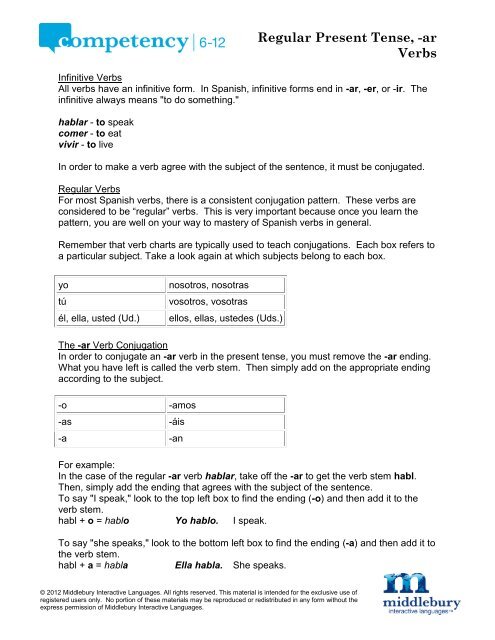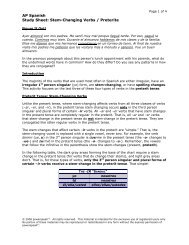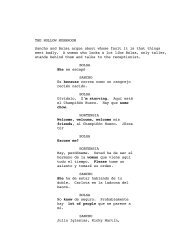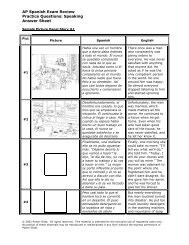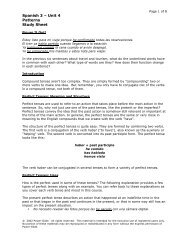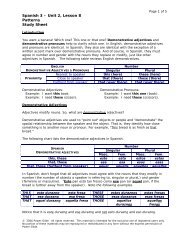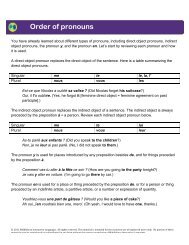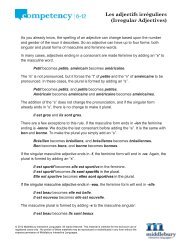Regular Present Tense, -ar Verbs
Regular Present Tense, -ar Verbs
Regular Present Tense, -ar Verbs
Create successful ePaper yourself
Turn your PDF publications into a flip-book with our unique Google optimized e-Paper software.
<strong>Regul<strong>ar</strong></strong> <strong>Present</strong> <strong>Tense</strong>, -<strong>ar</strong><br />
<strong>Verbs</strong><br />
Infinitive <strong>Verbs</strong><br />
All verbs have an infinitive form. In Spanish, infinitive forms end in -<strong>ar</strong>, -er, or -ir. The<br />
infinitive always means "to do something."<br />
habl<strong>ar</strong> - to speak<br />
comer - to eat<br />
vivir - to live<br />
In order to make a verb agree with the subject of the sentence, it must be conjugated.<br />
<strong>Regul<strong>ar</strong></strong> <strong>Verbs</strong><br />
For most Spanish verbs, there is a consistent conjugation pattern. These verbs <strong>ar</strong>e<br />
considered to be “regul<strong>ar</strong>” verbs. This is very important because once you le<strong>ar</strong>n the<br />
pattern, you <strong>ar</strong>e well on your way to mastery of Spanish verbs in general.<br />
Remember that verb ch<strong>ar</strong>ts <strong>ar</strong>e typically used to teach conjugations. Each box refers to<br />
a p<strong>ar</strong>ticul<strong>ar</strong> subject. Take a look again at which subjects belong to each box.<br />
yo nosotros, nosotras<br />
tú vosotros, vosotras<br />
él, ella, usted (Ud.) ellos, ellas, ustedes (Uds.)<br />
The -<strong>ar</strong> Verb Conjugation<br />
In order to conjugate an -<strong>ar</strong> verb in the present tense, you must remove the -<strong>ar</strong> ending.<br />
What you have left is called the verb stem. Then simply add on the appropriate ending<br />
according to the subject.<br />
-o -amos<br />
-as -áis<br />
-a -an<br />
For example:<br />
In the case of the regul<strong>ar</strong> -<strong>ar</strong> verb habl<strong>ar</strong>, take off the -<strong>ar</strong> to get the verb stem habl.<br />
Then, simply add the ending that agrees with the subject of the sentence.<br />
To say "I speak," look to the top left box to find the ending (-o) and then add it to the<br />
verb stem.<br />
habl + o = hablo Yo hablo. I speak.<br />
To say "she speaks," look to the bottom left box to find the ending (-a) and then add it to<br />
the verb stem.<br />
habl + a = habla Ella habla. She speaks.<br />
© 2012 Middlebury Interactive Languages. All rights reserved. This material is intended for the exclusive use of<br />
registered users only. No portion of these materials may be reproduced or redistributed in any form without the<br />
express permission of Middlebury Interactive Languages.
Let’s look at all the present tense conjugations for habl<strong>ar</strong>:<br />
<strong>Regul<strong>ar</strong></strong> <strong>Present</strong> <strong>Tense</strong>, -<strong>ar</strong><br />
<strong>Verbs</strong><br />
yo hablo nosotros/nosotras hablamos<br />
tú hablas vosotros/vosotras habláis<br />
él/ella/usted habla ellos/ellas hablan<br />
The <strong>Present</strong> <strong>Tense</strong><br />
The <strong>Present</strong> <strong>Tense</strong> in Spanish is usually used to talk about an action that is happening<br />
now, but it can also mean two slightly different things.<br />
In the case of the verb habl<strong>ar</strong>, it can mean:<br />
yo hablo I speak<br />
yo hablo I am speaking<br />
yo hablo I do speak<br />
Note: Since the verb changes to match the subject of the sentence, it is possible to<br />
leave the subject pronoun out of the sentence entirely. In fact, it is very common among<br />
native speakers.<br />
For example, instead of saying yo hablo (I speak) you can just say hablo.<br />
-AR <strong>Verbs</strong> © 2012 Middlebury Interactive Languages. Page 2


